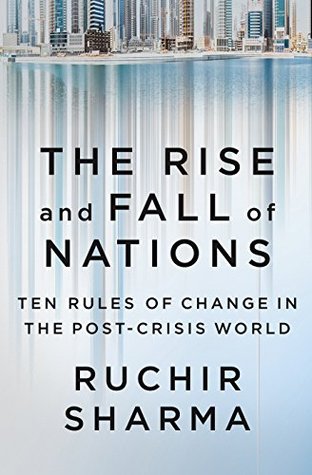More on this book
Community
Kindle Notes & Highlights
Read between
August 6 - August 18, 2017
When money dries up and trade recedes, so does economic growth.
“bloody ridiculous investment concept,”
The longest stagnation lasted twenty-three years and struck India starting in 1930,
But stagnations are at least as common as miracles and are perhaps more relevant to the AC era.
this book outlines ten rules for spotting whether a country is on the rise, on the decline, or just muddling through.
The first is impermanence.
the historical pattern for commodity prices—which tend to boom for a decade, then fall for two decades—was
to never forecast economic trends too far into the future.
the cycles of business, technology, and politics that shape economic growth are short, typically about five years.
The chapters in this book will show that long runs of strong growth last because leaders avoid the kinds of excesses that produce credit and investment bubbles, currency and bank crises and hyperinflation—the various kinds of busts that end economic miracles.
In general, however, if a country focuses on growth, development will follow.
My rules, therefore, offer a mix of ways to read hard data on things like credit, prices, and money flows, as well as softer signs of shifts in politics and policy.
These are the basic principles:
Recognize that any economy, no matter how successful or how broken, is more likely to return to the long-term average growth rate for its income class than to remain abnormally hot (or cold) indefinitely.
Growth can be defined as the sum of spending by government, spending by consumers, and investment
it is the most important indicator of change,
manufacturing remains central to understanding economic change.
In
many postwar cases the economy took off in educationally backward nations
In the AC era, the dominant economic storyline has been about debt:
Another simple way to define economic growth is as the sum of the hours that people work plus their output per hour or productivity.
The first rule addresses the economic impact of population growth, and most of the others deal one way or another with productivity.
a 1 percentage point decline in growth in the labor force will shave about 1 percentage point off economic growth.
debate rages as to whether the productivity decline is real.
To foreshadow the story in brief, an economy is most likely to begin rising steadily when the nation is emerging from crisis, has fallen off the radar of the global markets and media, and has chosen a democratic leader with a mandate to reform.
fewer young people are entering the working-age cohort, while the overall population is growing mainly because people are living longer. This mix is toxic for economic growth.
It pays off only if political leaders create the economic conditions necessary to attract investment and generate jobs.
Rapid population growth is often a precondition for fast economic growth, but it never guarantees fast growth.
Between 2011 and 2015 among the biggest gainers in the developed world were Australia, Canada, the United States, and Germany.
the key to driving economic growth is not so much individual experts as the combination of expertise required to make complex products: for example, the mix of experience in batteries, liquid crystals, semiconductors, software, metallurgy, and lean manufacturing required to make a smartphone.
even the most promising reformers tend to grow stale and arrogant with time, with decisive consequences for their economies.
the natural circle of political life, in which a crisis forces a nation to reform, reform leads to growth and good times, and good times encourage an arrogance and complacency that leads to a new crisis.
Nations are most likely to change for the better when they are struggling to recover from a crisis.
nations are most likely to change for the worse in boom times,
The second step is to figure out whether the country has a political leader capable of rallying the popular will behind reform.
The least auspicious periods come under stale leaders, who tend to hang on to power by passing out government largesse as a reward to powerful allies and to a complacent populace.
The occasional successes and frequent failures of political leaders are central to the rise and fall of nations,
pinpointing when a country is ready to make hard changes is more important than identifying the specific content of the reform.
A good crisis raises the probability that a nation will embrace change and new leaders, but it is very hard to say which new leaders will be successful reformers.
Some countries will turn to populists promising easy prosperity and a restoration of national glory,
In the United States and Britain, that template included some mix of loosening central control over the economy, cutting taxes and red tape, privatizing state companies, and lifting price controls while supporting the central bank policies that played the critical role in taming inflation.
While reform is most likely under bold new leaders, it grows less likely as time passes, as the leader’s focus turns to securing a grand legacy or rewarding family and friends.
high-impact reform is most likely in a leader’s first term,
China has also followed a strong tradition of completely overhauling its leadership every ten years.
there was no clear link between growth in the middle class and the rise of middle-class protest.
The stronger link among these protests was their target:
Every one of them targeted an aging and com...
This highlight has been truncated due to consecutive passage length restrictions.
every one of those eruptions came against a regime that had been in power for longer than eight years and had failed to keep pace with the economic challenges of the post-crisis world.
even strong leaders will lose reform momentum, the longer they stay in power.
Beware when presidents start firing the reformers on their staff.


